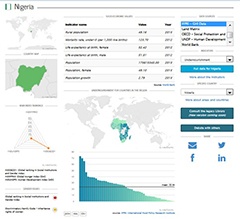For the past three years, the Global Hunger Index (GHI), a tool designed to comprehensively measure and track hunger by region and country, has been published as Linked Open Data (LOD). The GHI highlights successes and failures in hunger reduction and provides insights into the drivers of hunger, as well as food and nutrition insecurity. It does so by combining three equally weighted indicators—undernourishment, child underweight, and child mortality—into a single comprehensive index.
Building upon this work, IFPRI’s Communications and Knowledge Management Division recently published the raw, structured data behind the GHI, which is available here in Resource Description Framework (RDF). This RDF file includes GHI scores and underlying indicator values for countries from 1990-2013.
The GHI, presented as Linked Open Data, can be combined with other relevant data—such as GIS, and indicators such as social protection and food security—to be easily used and repurposed by developers and researchers to visualize and address global hunger issues. For example, the African Growth and Development Policy Modelling Consortium (AGRODEP)and the Land Portal have integrated GHI LOD with other key statistics in their country profile pages to provide a consolidated and comparative view of a country’s progress toward reducing hunger.
The GHI data also is available through the GHI interactive tool (Tableau), which allows for even wider access and repurposing of the underlying data. Michael Mixon from Seagate Technology created a new product titled “How have the results of the GHI (Global Hunger Index) changed since 1990?” which repurposes the underlying data from Tableau as new visualizations in the form of interactive charts and figures.
IFPRI also developed a SPARQL (pronounced “sparkle”) endpoint to enable users and machines to query the dataset, manipulate the source data, and create new applications. As with other IFPRI data, users can explore, access, and remix key data via IFPRI’s SPARQL endpoint or simply by visiting IFPRI’s online data gateway.
More Linked Open Data (LOD) from IFPRI:
- Agricultural Science and Technology Indicators (ASTI) LOD
- Statistics of Public Expenditure for Economic Development (SPEED) LOD
- Arab Spatial LOD
Note: Luz Marina Alvaré is IFPRI’s Head of Knowledge Management. Cristina Perez, Knowledge Management Systems Coordinator at IFPRI, produced the Resource Description Framework (RDF) for the 2014 Global Hunger Index. Nilam Prasai, IFPRI’s Data Curator, has produced data visualizations using Tableau every year since 2011.







